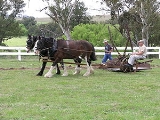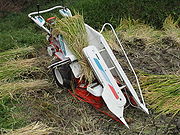
Binder
Encyclopedia

Reaper
A reaper is a person or machine that reaps crops at harvest, when they are ripe.-Hand reaping:Hand reaping is done by various means, including plucking the ears of grains directly by hand, cutting the grain stalks with a sickle, cutting them with a scythe, or with a later type of scythe called a...
. The binder was invented in 1872 by Charles Withington. In addition to cutting the small-grain crop, it would also tie the stems into small bundles, or sheaves. These sheaves were then 'shocked' into conical stook
Stook
A stook, also referred to as a shock is a circular or rounded arrangement of swathes of cut grain stalks placed on the ground in a field. Typically sheaves of grains such as wheat, barley and oats may be 'stooked' so they are ready for threshing....
s, resembling small tipi
Tipi
A tipi is a Lakota name for a conical tent traditionally made of animal skins and wooden poles used by the nomadic tribes and sedentary tribal dwellers of the Great Plains...
s, to allow the grain to dry for several days before being threshed
Threshing
Threshing is the process of loosening the edible part of cereal grain from the scaly, inedible chaff that surrounds it. It is the step in grain preparation after harvesting and before winnowing, which separates the loosened chaff from the grain...
.
Withington's original binder used wire to tie the bundles. There were various problems with using wire and it was not long before William Deering
William Deering
William Deering was an American businessman and philanthropist.He inherited a woolen mill in Maine, but made his fortune in later life with the Deering Harvester Company.-Life:Deering was born April 25, 1826 in South Paris, Maine...
invented a binder that used twine
Twine
Twine is a light string or strong thread composed of two or more smaller strands or yarns twisted together. More generally, the term can be applied to any thin cord....
and a knotter (invented in 1858 by John Appleby
John Appleby
John Francis Appleby was an American inventor who developed a knotting device to bind grain bundles with twine, which became the foundation for all farm grain binding machinery and was used extensively by all the major manufacturers of large grain harvesting machines in the late 19th and early...
).
Early binders were horse-drawn and powered by a bull wheel. Later models were tractor-drawn. The implement had a reel and a sickle bar
Mower
A mower is a machine for cutting grass or other plants that grow on the ground. Usually mowing is distinguished from reaping, which uses similar implements, but is the traditional term for harvesting grain crops, e.g...
, like a modern grain head for a combine harvester
Combine harvester
The combine harvester, or simply combine, is a machine that harvests grain crops. The name derives from the fact that it combines three separate operations, reaping, threshing, and winnowing, into a single process. Among the crops harvested with a combine are wheat, oats, rye, barley, corn ,...
, or combine. The cut stems would fall onto a canvas
Canvas
Canvas is an extremely heavy-duty plain-woven fabric used for making sails, tents, marquees, backpacks, and other items for which sturdiness is required. It is also popularly used by artists as a painting surface, typically stretched across a wooden frame...
, which conveyed the crop to the binding mechanism. This mechanism bundled the stems of grain and tied a piece of twine around the bundle. Once tied, it was discharged from the back of the binder.
With the replacement of the threshing machine
Threshing machine
The thrashing machine, or, in modern spelling, threshing machine , was a machine first invented by Scottish mechanical engineer Andrew Meikle for use in agriculture. It was invented for the separation of grain from stalks and husks. For thousands of years, grain was separated by hand with flails,...
by the combine harvester
Combine harvester
The combine harvester, or simply combine, is a machine that harvests grain crops. The name derives from the fact that it combines three separate operations, reaping, threshing, and winnowing, into a single process. Among the crops harvested with a combine are wheat, oats, rye, barley, corn ,...
, the binder became almost obsolete. Some grain crops such as oat
Oat
The common oat is a species of cereal grain grown for its seed, which is known by the same name . While oats are suitable for human consumption as oatmeal and rolled oats, one of the most common uses is as livestock feed...
s are now cut and formed into windrows with a swather
Swather
A swather, or windrower, is a farm implement that cuts hay or small grain crops and forms them into a windrow. "Swather" is predominantly the North American term for these machines...
. With other grain crops such as wheat
Wheat
Wheat is a cereal grain, originally from the Levant region of the Near East, but now cultivated worldwide. In 2007 world production of wheat was 607 million tons, making it the third most-produced cereal after maize and rice...
, the grain is now mostly cut and threshed by a combine in a single operation, while the binder is still in use at small fields or outskirts of mountain areas.

